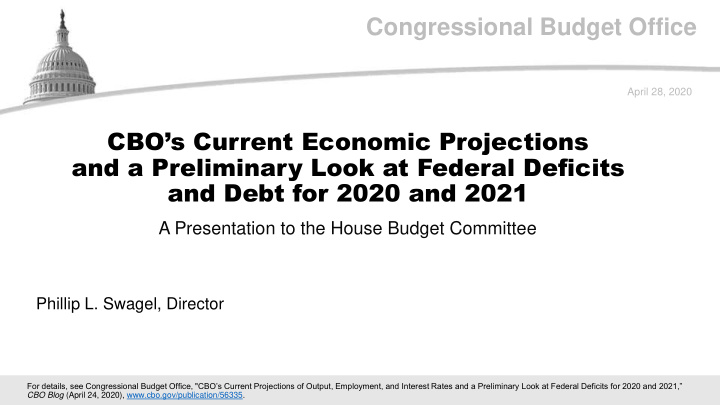



Congressional Budget Office April 28, 2020 CBO’s Current Economic Projections and a Preliminary Look at Federal Deficits and Debt for 2020 and 2021 A Presentation to the House Budget Committee Phillip L. Swagel, Director For details, see Congressional Budget Office, "CBO’s Current Projections of Output, Employment, and Interest Rates and a Prel imi nary Look at Federal Deficits for 2020 and 2021,” CBO Blog (April 24, 2020), www.cbo.gov/publication/56335.
CBO Unemployment Rate CBO expects the unemployment rate to average 15 percent in the second and third quarters of 2020, higher than at any point since the early 1930s. The unemployment rate is the number of jobless people who are available for and seeking work, expressed as a percentage of the labor force. 1
CBO Labor Force in the Third Quarter of 2020 By the third quarter of this year, about 28 million fewer people will be employed and about 9 million fewer people will be in the labor force than CBO projected in January. The labor force is the number of people in the civilian noninstitutionalized population who are either working or seeking work. 2
CBO CBO’s Economic Projections for 2020 and 2021 2020 Annual Q1 Q2 Q3 Q4 2020 2021 Real GDP (Percentage change from preceding quarter) a -0.9 b -11.8 b 5.4 c 2.5 n.a. b n.a. b Real GDP (Percentage change, The nation’s output is annual rate) a -3.5 b -39.6 b 23.5 c 10.5 -5.6 b 2.8 b projected to decline GDP sharply in the second (Trillions of dollars) 21.6 b 19.1 b 20.1 c 20.7 20.4 b 21.3 b quarter of this year and Unemployment Rate to begin rising thereafter. (Percent) 3.8 c 14.0 c 16.0 c 11.4 b 10.1 b 11.7 Interest Rate on Three-Month Treasury Bills (Percent) 1.1 b 0.1 b 0.1 c 0.1 0.4 b 0.1 b Interest Rate on Ten-Year Treasury Notes (Percent) 1.4 b 0.6 b 0.7 c 0.7 0.8 b 0.7 b GDP = gross domestic product; n.a. = not applicable. a. Real values are nominal values that have been adjusted to remove the effects of changes in prices. b. Data are shown on a fourth-quarter-to-fourth-quarter basis. 3
CBO Real GDP Relative to CBO’s January 2020 Projection Output at the end of 2021 would be more than 6 percent lower than CBO projected in January. Real values are nominal values that have been adjusted to remove the effects of changes in prices. GDP = gross domestic produc t. 4
CBO Budget Deficits CBO projects that if current laws generally did not change, the federal deficit would be roughly $3.7 trillion in fiscal year 2020 and $2.1 trillion in fiscal year 2021. At 17.9 percent of GDP, the 2020 deficit would be the largest since 1945. 5
CBO Federal Debt Held by the Public CBO projects that federal debt held by the public would grow to 108 percent of GDP by the end of fiscal year 2021, up from 79 percent at the end of fiscal year 2019 — again, if current laws generally did not change. That percentage in 2021 would be the highest in U.S. history. 6
CBO CBO is working to inform the Congress about the economic and budgetary consequences of the coronavirus pandemic, providing analysis that supports the Congress as it continues to respond to the crisis. To find other work by CBO related to the pandemic, see www.cbo.gov/topics/covid-19. 7
Recommend
More recommend